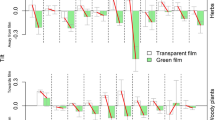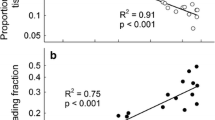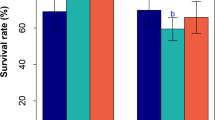Abstract
Plant form and spatial structure reflect the basic architectural blue-print of a plant. In most plant species, the expression of the structural blue-print is systematically altered during ontogeny resulting in predictable changes in the allometry of plant structures and in the types of structures that are produced. The expression of the structural blue-print or the timing of ontogenetic changes is also frequently altered by environmental conditions. This latter source of variability, referred to as phenotypic plasticity, is manifested through changes in the timing and rates of meristem initiation and development, the likelihood that meristems will remain dormant or commit to different demographic fates (i.e., vegetative vs. reproductive structures), or the size and structure of the organs formed. Complex interactions among these components can result in considerable differences in form and spatial structure among individuals of the same species. This paper focuses on the importance of these different components in determining the architecture of clonal plants with long internode connections between ramets.
A case study is presented that attempts to separate ontogenetic variation and phenotypic plasticity in two stoloniferous species with different structural blue-prints, in their responses to shading. In both species the rate of ontogenetic development responded to intermediate shading levels, but only at very low levels of light availability did plastic changes in branch formation occur. Under shaded conditions the two species achieved similar changes in their architecture in conspicuously different ways. We discuss how different mechanisms leading to a given architecture can be distinguished and what the ecological implications of this are.
Similar content being viewed by others
References
Ackerly, D. D., Coleman, J. S., Morse, S. R. & Bazzaz, F. A. 1992. CO2 and temperature effects on leaf area production in two annual plant species. Ecology 73: 1260-1269.
Bell, A. D. 1984. Dynamic morphology: A contribution to plant population biology. Pp. 48-65. In: Dirzo R. & Sarukhán J. (eds) Perspectives on Plant Population Biology. Sinauer Associates Inc., Sunderland.
Bell, A. D. 1991. Plant Form. An Illustrated Guide to Flowering Plant Morphology. Oxford University Press, Oxford.
Birch, C. P. D. & Hutchings, M. J. 1992a. Analysis of ramet development in the stoloniferous herb Glechoma hederacea using a plastochron index. Oikos 63: 387-394.
Birch, C. P. D. & Hutchings, M. J. 1992b. Stolon growth and branching in Glechoma hederacea L.: an application of a plastochron index. New Phytol. 122: 545-551.
Bradshaw, A. D. 1965. Evolutionary significance of phenotypic plasticity in plants. Adv. Genet. 13: 115-155.
Carlsson, B. Å. & Callaghan, T. V. 1990. Programmed tiller differentiation, intraclonal density regulation and nutrient dynamics in Carex bigelowii. Oikos 28: 219-230.
Casal, J. J., Sánchez, R. A. & Deregibus, V. A. 1987. Tillering responses of Lolium multiflorum plants to changes of red/far-red ratio typical of sparse canopies. J. Exp. Bot. 38: 1432-1439.
Coleman, J. S. & McConnaughay, K. D. M. 1995. A non-functional interpretation of a classical optimal-partitioning example. Funct. Ecol. 9: 951-954.
Coleman, J. S., McConnaughay, K. D. M. & Ackerly, D. D. 1994. Interpreting phenotypic variation in plants. TREE 9: 187-191.
Cook, R. E. 1985. Growth and development in clonal plant populations. Pp. 259-296. In: Jackson J. B. C., Buss L.W. & Cook R. E. (eds), Population Biology and Evolution of Clonal Organisms. Yale University Press, New Haven.
de Kroon, H. & Hutchings, M. J. 1995. Morphological plasticity in clonal plants: the foraging concept reconsidered. J. Ecol. 83: 143-152.
de Kroon, H. & Schieving, F. 1990. Resource partitioning in relation to clonal growth strategy. Pp. 113-130. In: van Groenendael J. & de Kroon H. (eds) Clonal Growth in Plants: Regulation and Function. SPB Academic Publishing, The Hague.
de Kroon, H., Stuefer, J. F., Dong, M. & During, H. J. 1994.On plastic and non-plastic variation in clonal plant morphology and its ecological significance. Folia Geobot. Phytotax. 29: 123-138.
Deregibus, V. A., Sánchez, R. A., Casal, J. J. & Trlica, M. J. 1985. Tillering responses to enrichment of red light beneath a canopy in a humid natural grassland. J. Appl. Ecol. 22: 199-206.
Diggle, P. K. 1994. The expression of andromonoecy in Solanum hirtum (Solanaceae): phenotypic plasticity and ontogenetic contingency. Am. J. Bot. 81: 1354-1365.
Dong, M. 1994. Foraging through morphological plasticity in clonal herbs. Ph.D. Thesis, Utrecht University, The Netherlands.
Drew, M. C. & Saker, L. R. 1975. Nutrient supply and the growth of the seminal root system in barley. II. Localized, compensatory increase in lateral root growth and rates of nitrate uptake when nitrate supply is restricted to only part of the root system. J. Exp. Bot. 26: 79-90.
Dudley, S. A. & Schmitt, J. 1995. Genetic differentiation in morphological responses to simulated foliage shade between populations of Impatiens capensis from open and woodland sites. Funct. Ecol. 9: 655-666.
Dudley, S. A. & Schmitt, J. 1996. Testing the adaptive plasticity hypothesis: density-dependent selection on manipulated stem length in Impatiens capensis. Am. Nat. 147: 445-465.
Evans, C. G. 1972. The Qualitative Analysis of Plant Growth. Blackwell Scientific Publications, Oxford.
Evans, J. P. 1992. The effect of local resource availability and clonal integration on ramet functional morphology in Hydrocotyle bonariensis. Oecologia 89: 265-276.
Geber, M. A., Watson, M. A. & de Kroon, H. 1997. Organ preformation, development, and resource allocation in perennials. Pp. 113-141. In: Bazzaz F. A. & Grace J. (eds), Plant resource allocation. Academic Press.
Geber, M. A., Watson, M. A. & Furnish, R. 1992. Genetic differences in the clonal demography in Eichhornia crassipes. J. Ecol. 80: 329-341.
Gersani, M. & Sachs, T. 1992. Developmental correlations between roots in heterogeneous environments. Plant, Cell and Environment 15: 463-469.
Gifford, E. M. & Foster, A. S. 1988. Morphology and Evolution of Vascular Plants. Freeman & Co, New York.
Grime, J. P., Crick, J. C. & Rincon, J. E. 1986. The ecological significance of plasticity. Pp. 4-29. In: Jennings D. H. & Trewavas A. J. (eds) Plasticity in Plants. Cambridge University Press, Cambridge.
Harper, J. L. & White, J. 1974. The demography of plants. Ann. Rev. Ecol. Syst. 5: 419-463.
Huber, H. 1995. Growth form and plasticity of the hybrid Potentilla anglica and its two parent species. Ab. Bot. 19: 61-73.
Huber, H. 1996. Plasticity of internodes and petioles in prostrate and erect Potentilla species. Funct. Ecol. 10: 401-409.
Huber, H., Fijan, A. & During, H. J. 1998. A comparative study of spacer plasticity in erect and stoloniferous herbs. Oikos 81: 576-586.
Huber, H. & Stuefer, J. F. 1997. Shade-induced changes in the branching pattern of a stoloniferous herb: functional response or allometric effect? Oecologia: 478-486.
Hutchings, M. J. & de Kroon, H. 1994. Foraging in plants: the role of morphological plasticity in resource acquisition. Adv. Ecol. Res. 25: 159-238.
Jamadagni, B. M., Patil, R. B. & Birari, S. P. 1995. Plastochron index in relation to water stress in cowpea. Biol. Plant. 37: 139-142.
Lamoreaux, R. J., Chaney, W. R. & Brown, K. M. 1978. The plastochron index: a review after two decades of use. Amer. J. Bot. 65: 586-593.
Larcher, W. 1994. Ökophysiologie der Pflanzen: Leben, Leistung und Stre_bewältigung der Pflanzen in ihrer Umwelt. Verlag Eugen Ulmer, Stuttgart.
Lukács, S. 1997. Effect of light intensity on the development of branching patterns in the two clonal herb species: Potentilla reptans and Glechoma hederacea. MSc Thesis, Utrecht University.
Maksymowych, R. 1990. Analysis of Growth and Development of Xanthium. Cambridge University Press, Cambridge.
Novoplansky, A., Cohen, D. & Sachs, T. 1990. How Portulaca seedlings avoid their neighbours. Oecologia 82: 490-493.
Price, E. A. C. & Hutchings, M. J. 1992. Studies of growth in the clonal herb Glechoma hederacea II. The effects of selective defoliation. J. Ecol. 80: 39-47.
Robin, C., Hay, M. J. M. & Newton, P. C. D. 1994a. Effect of light quality (red: far-red ratio) and defoliation treatments applied at a single phytomer on axillary bud outgrowth in Trifolium repens L. Oecologia 100: 236-242.
Robin, C., Hay, M. J. M., Newton, P. C. D. & Greer, D. H. 1994b. Effect of light quality (red:far-red ratio) at the apical bud of the main stolon on morphogenesis of Trifolium repens. Ann. Bot. 74: 119-123.
Robinson, D. 1994. The response of plants to non-uniform supplies of nutrients. New Phytol. 127: 635-674.
Salzman, A. G. 1985. Habitat selection in a clonal plant. Science 228: 603-604.
Scheiner, S. M. 1993. Genetics and evolution of phenotypic plasticity. Ann. Rev. Ecol. Syst. 24: 35-68.
Schmitt, J., McCormac, A. C. & Smith, H. 1995. A test of the adaptive plasticity hypothesis using transgenic and mutant plants disabled in phytochrome-mediated responses to neighbors. Am. Nat. 146: 937-953.
Schmitt, J. & Wulff, R. D. 1993. Light spectral quality, phytochrome and plant competition. TREE 8: 47-51.
Silk, W. K. 1980. Plastochron indices in cantaloupe grown on an irrigation line source. Bot. Gaz. 141: 73-78.
Slade, A. J. & Hutchings, M. J. 1987. The effects of light intensity on foraging in the clonal herb Glechoma hederacea. J. Ecol. 75: 639-650.
Stuefer, J. F. 1996. Potential and limitations of current concepts regarding the response of clonal plants to environmental heterogeneity. Vegetatio 127: 55-70.
Stuefer, J. F., de Kroon, H. & During, H. J. 1996. Exploitation of environmental heterogeneity by spatial division of labour in a clonal plant. Funct.Ecol. 10: 328-334.
Stuefer, J. F., During, H. J. & de Kroon, H. 1994. High benefits of clonal integration in two stoloniferous species, in response to heterogeneous light environments. J. Ecol. 82: 511-518.
Stuefer, J. F. & Hutchings, M. J. 1994. Environmental heterogeneity and clonal growth: a study of the capacity for reciprocal translocation in Glechoma hederacea L. Oecologia 100: 302-308.
Sutherland, W. J. & Stillman, R. A. 1988. The foraging tactics of plants. Oikos 52: 239-244.
Tomlinson, P. B. 1982. Chance and design in the construction of plants. Acta Biotheoretica 31A: 162-183.
Troll, W. 1935. Vergleichende Morphologie der höheren Pflanzen. Verlag von Gebrüder Borntraeger, Berlin.
Turkington, R., Sackville Hamilton, R. & Gliddon, C. 1991.Withinpopulation variation in localized and integrated responses of Trifolium repens to biotically patchy environments. Oecologia 86: 183-192.
Watkinson, A. R. & White, J. 1986. Some life-history consequences of modular construction in plants. Phil. Trans. R. Soc. Lond. B 313: 31-51.
Watson, M. A. & Cook, G. S. 1987. Demographic and developmental differences among clones of water hyacinth. J. Ecol. 75: 439-457.
Watson, M. A., Geber, M. A. & Jones, C. S. 1995. Ontogenetic contingency and the expression of plant plasticity. TREE 10: 474-475.
Watson, M. A., Hay, M. J. M. & Newton, P. C. D. 1997. Developmental phenology and the timing of determination of shoot bud fates: ways in which the developmental program modulates fitness in clonal plans. Pp.31-53. In: de Kroon H. & van Groenendael J. (eds), The ecology and evolution of clonal plants. Backhuys Publishers, Leiden.
Author information
Authors and Affiliations
Rights and permissions
About this article
Cite this article
Huber, H., Lukács, S. & Watson, M.A. Spatial structure of stoloniferous herbs: an interplay between structural blue-print, ontogeny and phenotypic plasticity. Plant Ecology 141, 107–115 (1999). https://doi.org/10.1023/A:1009861521047
Issue Date:
DOI: https://doi.org/10.1023/A:1009861521047




